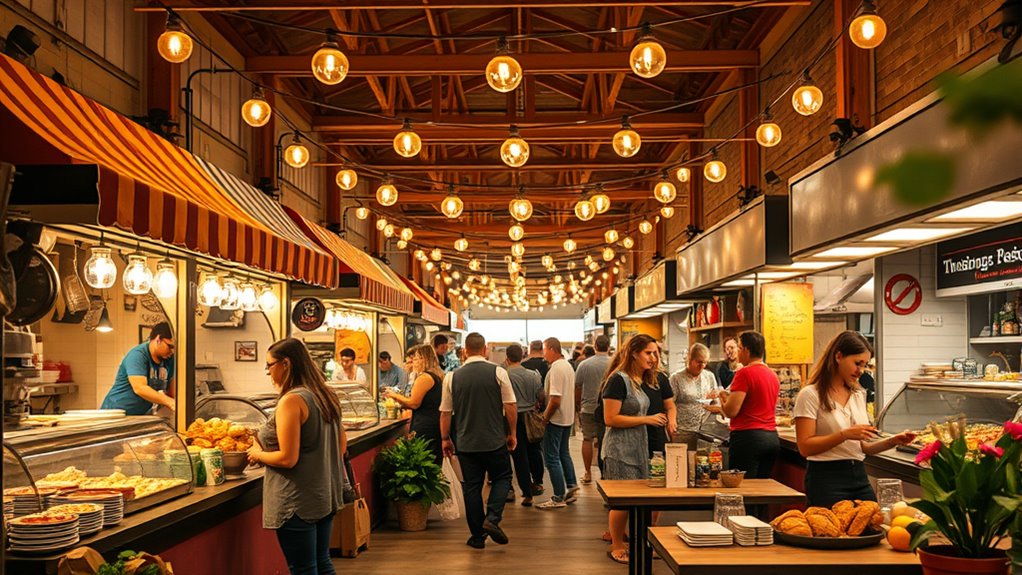Micro-food halls in suburbs are transforming how you enjoy diverse, multicultural cuisines in lively, communal spaces. They feature multiple vendors offering everything from comfort foods to international favorites, all in a vibrant environment that supports local entrepreneurs. These halls boost community engagement and revitalize neighborhoods, creating inviting spots for residents. If you’re curious about how these dynamic food hubs foster cultural exchange and community spirit, explore more insights ahead.
Key Takeaways
- Micro-food halls are transforming suburban dining by offering diverse cuisines in a communal, modern space that boosts local economies.
- They feature multiple vendors sharing a compact area with cultural decor, fostering inclusivity and cultural exchange.
- These venues support small entrepreneurs with affordable booths, increasing vendor diversity and community engagement.
- Managing suburban micro-food halls involves overcoming challenges like limited foot traffic and operational costs through strategic design and marketing.
- Future trends include digital integration, sustainability initiatives, and hybrid online-offline models to enhance visitor experience and vendor success.
The Rise of Micro-Food Halls in Suburban Areas
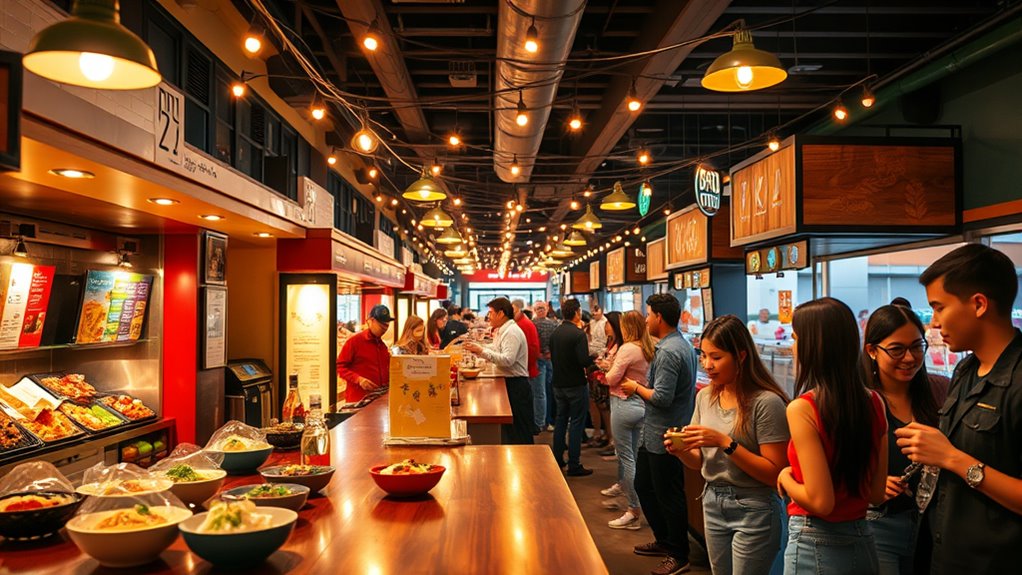
Have you noticed how micro-food halls are transforming suburban dining scenes? These compact spaces are sprouting up in neighborhoods where traditional restaurants once dominated. You’ll find a variety of vendors sharing a single location, offering diverse cuisines without the need for a full-scale restaurant. This shift caters to busy locals seeking quick, flavorful options close to home. Micro-food halls often feature modern design, communal seating, and a lively atmosphere that appeals to a broad demographic. They provide an accessible platform for small chefs and entrepreneurs to showcase their creations without the overhead of a standalone restaurant. As a result, these hubs are revitalizing suburban areas, making dining more convenient, diverse, and community-oriented. The rise of micro-food halls signals a new era of casual, vibrant, and flexible food experiences. Additionally, these venues often incorporate innovative layouts that maximize space efficiency and enhance the customer experience.
Key Features That Set Micro-Food Halls Apart
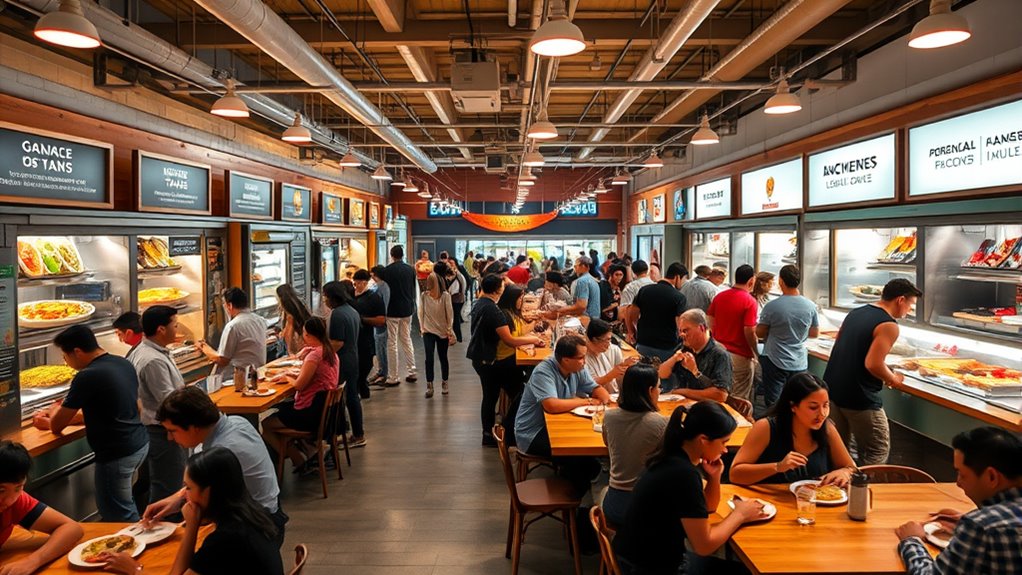
You’ll notice that micro-food halls are compact spaces that pack in a variety of cuisines. Their diverse menus give you plenty of options without leaving the neighborhood. Plus, the community-focused atmosphere makes these spots feel welcoming and local.
Compact, Diverse Menus
What makes micro-food halls stand out is their ability to offer a compact yet diverse menu that appeals to a wide range of tastes. You’ll find a carefully curated selection of vendors, each serving unique dishes without overwhelming space. This setup allows you to explore different cuisines—think sushi, tacos, vegetarian options, and comfort foods—all in one visit. The menus are designed to maximize variety while maintaining efficiency, so you can sample multiple flavors without feeling rushed. Each vendor specializes in a specific offering, ensuring quality and authenticity. This diversity attracts a broad audience, from families to food enthusiasts, giving everyone the chance to enjoy a culinary adventure in a single, convenient location. Incorporating diverse cuisines is a key feature that helps micro-food halls stand out from traditional food courts.
Community-Focused Atmosphere
What truly sets micro-food halls apart is their emphasis on fostering a sense of community. Here, you’re not just grabbing a quick bite; you’re connecting with local vendors and neighbors. These spaces encourage interaction, whether through shared seating, communal tables, or lively events. The atmosphere is warm and inviting, making everyone feel welcome. Vendors often know their customers by name, creating a personal touch that large food courts lack. This sense of belonging turns a simple meal into a shared experience. Micro-food halls prioritize local culture and relationships, helping you feel more connected to your neighborhood. Additionally, the community-oriented environment often includes events and activities that further enhance local engagement. Whether you’re visiting for a casual lunch or a weekend gathering, you’ll sense the genuine community spirit that these spaces cultivate.
How Micro-Food Halls Support Local Entrepreneurs
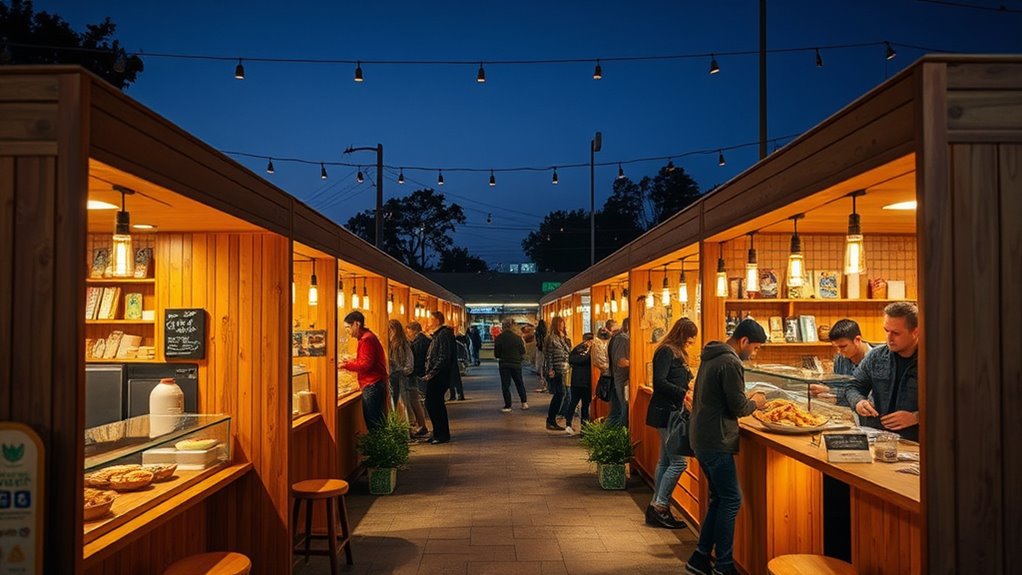
Micro-food halls provide a unique platform for local entrepreneurs to showcase their culinary talents and grow their businesses. They offer affordable booth spaces, reducing startup costs and lowering barriers to entry. By sharing a communal space, entrepreneurs gain exposure to diverse customer bases and benefit from increased foot traffic. These halls also foster networking opportunities, allowing vendors to learn from each other and collaborate. Additionally, micro-food halls often handle marketing and maintenance, letting entrepreneurs focus on creating great food. Incorporating community engagement can further strengthen vendor success and customer loyalty within these spaces.
Popular Cuisines and Food Concepts Found in Suburban Micro-Halls
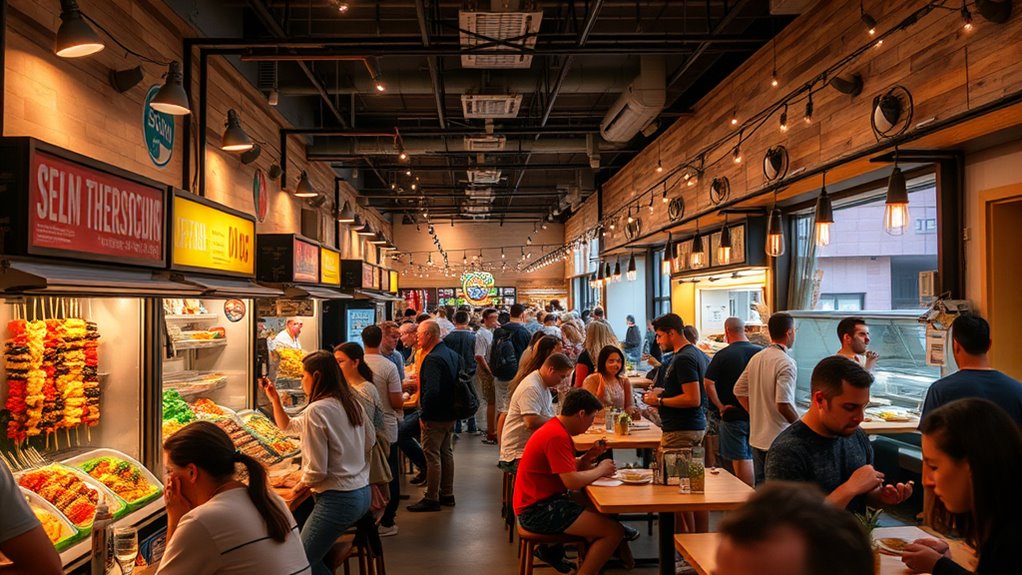
Suburban micro-food halls feature a diverse array of cuisines and food concepts that cater to local tastes and preferences. You’ll find everything from classic American comfort foods to international flavors like Mexican tacos, Korean bibimbap, and Indian curries. Many halls emphasize fusion concepts, blending different culinary traditions into innovative dishes. Food trucks and small stalls often showcase specialty concepts, such as vegan bowls, gourmet burgers, or artisanal desserts. You might also discover health-conscious options like smoothie bars and organic snack vendors. The focus is on variety and quality, giving you the chance to try multiple cuisines in one place. This diversity reflects the community’s multicultural makeup and evolving food trends, making micro-food halls exciting hubs for culinary exploration.
Benefits for Residents and the Community
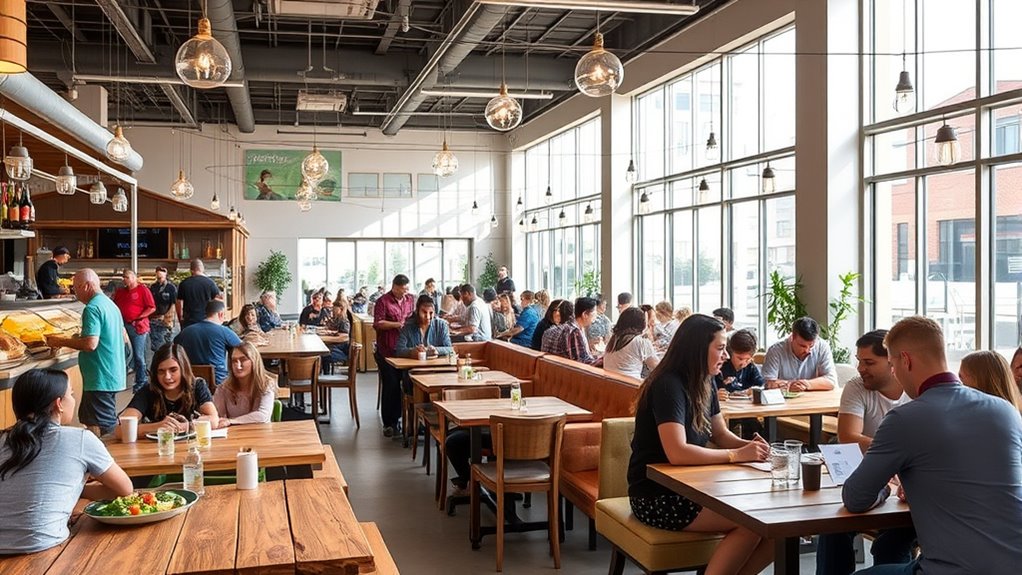
Residents and the community directly benefit from the diverse offerings and vibrant atmosphere of micro-food halls. They create a lively social hub where neighbors can connect and share experiences. These spaces also boost local economies by supporting small vendors and entrepreneurs. You’ll find affordable, high-quality food options that make dining out more accessible. Plus, micro-food halls foster cultural exchange, exposing you to different cuisines and traditions. Incorporating small vendor support through these venues further strengthens local business networks and promotes community resilience.
Designing Inviting Spaces for a Diverse Crowd

To create welcoming micro-food halls, you should incorporate varied seating options that suit different preferences. Adding cultural decor elements can make the space feel more inclusive and reflective of the community’s diversity. When you pay attention to these details, you invite a broader crowd to enjoy the experience. Incorporating color accuracy in design elements can also subtly enhance the ambiance and overall aesthetic appeal.
Varied Seating Arrangements
Designing varied seating arrangements is essential for creating micro-food halls that feel welcoming to everyone. You want to encourage comfortable socializing and accommodate different group sizes and preferences. Mix communal tables with cozy booths and individual seats to appeal to diverse patrons. Consider flexible options like movable chairs and tables so spaces can adapt throughout the day. Incorporate outdoor seating or patio areas for those who prefer fresh air. Think about creating zones that cater to different needs, such as quick bites or longer meals. This variety invites a broader crowd and makes your space more versatile. Ultimately, a mix of seating styles helps foster a lively, inclusive environment where everyone feels at home.
Cultural Decor Elements
Incorporating cultural decor elements transforms a micro-food hall into a vibrant, inviting space that celebrates diversity. You can achieve this by showcasing artwork, textiles, and symbols from various cultures, creating a warm, inclusive atmosphere. Use colorful murals or traditional crafts as focal points to spark curiosity and conversation. Incorporate diverse tableware, patterns, and decorative items that reflect different regions, making everyone feel represented. Lighting plays a vital role—think lanterns, string lights, or ethnic-inspired fixtures that add ambiance. Be mindful of authenticity, sourcing pieces that genuinely represent each culture. Additionally, paying attention to cultural sensitivity ensures respectful and meaningful decor choices. These decor elements not only enhance visual interest but also foster a sense of belonging for your diverse crowd, encouraging repeat visits and positive word-of-mouth.
Challenges and Opportunities in Managing Micro-Food Halls

Managing micro-food halls in suburban areas presents both significant opportunities and unique challenges. You can tap into local communities, offering diverse cuisine options that attract loyal customers. However, you’ll also face hurdles like limited foot traffic, higher operational costs, and competition from larger food venues. To succeed, you need to:
Managing suburban micro-food halls offers community-focused opportunities amid foot traffic and operational challenges.
- Build strong relationships with local vendors and customers
- Optimize space and layout for efficiency
- Implement targeted marketing strategies
- Manage costs carefully without compromising quality
- Be aware of potential emotional manipulation from competitors or partners that could impact your operations
Balancing the intimate, community-focused vibe with operational demands is key. While attracting consistent patronage can be tough, the potential for personalized experiences and supporting small businesses creates a unique edge. Charting these challenges carefully opens doors to thriving suburban food hubs.
Future Trends Shaping Suburban Food Halls

As technology continues to evolve, it’s reshaping how suburban food halls operate and attract customers. You’ll see more integration of digital ordering systems, allowing patrons to browse menus and order from their phones, reducing wait times. Virtual reality and augmented reality experiences are emerging, offering immersive ways to explore food options or learn about vendors. Data analytics help food halls personalize marketing and optimize vendor mix based on customer preferences. Sustainability remains a priority; expect more eco-friendly packaging and waste reduction initiatives. Additionally, hybrid models combining physical spaces with online platforms will grow, enabling you to enjoy food hall offerings both in person and remotely. These trends will make food halls more convenient, engaging, and environmentally conscious, shaping the future of suburban dining experiences. The incorporation of digital technology is also expected to improve operational efficiency and customer satisfaction.
Frequently Asked Questions
How Do Micro-Food Halls Differ From Traditional Food Courts?
You might wonder how micro-food halls differ from traditional food courts. Micro-food halls focus on small, specialized vendors offering unique, high-quality dishes, often with a trendy vibe. They usually have a more intimate setting and emphasize local or artisanal foods. Traditional food courts tend to feature larger chains with a wide variety of generic options, often in a more crowded, commercial environment. Micro-food halls create a more curated, community-focused experience.
What Is the Typical Cost to Set up a Micro-Food Hall?
Imagine you’re back in a bustling 80s arcade, excited for the next game. Setting up a micro-food hall costs typically between $250,000 to $500,000, depending on size, location, and concept. You’ll need to budget for permits, equipment, furniture, and initial inventory. Keep in mind, costs can vary widely, so planning carefully and securing good tenants can help you create a vibrant, profitable space without breaking the bank.
Are Micro-Food Halls Sustainable and Environmentally Friendly?
You’re wondering if micro-food halls are sustainable and eco-friendly. They can be, especially when you prioritize local sourcing, minimize waste, and implement energy-efficient equipment. By encouraging vendors to use eco-friendly packaging and composting practices, you reduce environmental impact. While they have potential, it’s essential for you to actively promote green initiatives within your micro-food hall to guarantee long-term sustainability and a positive environmental footprint.
How Do Micro-Food Halls Impact Local Property Values?
Did you know that developments like micro-food halls can boost nearby property values by up to 10%? They often make neighborhoods more attractive, offering diverse dining options that appeal to residents and visitors alike. By creating lively, communal spaces, micro-food halls can enhance local appeal and desirability. As a result, property values tend to rise, benefiting homeowners and attracting new investments to the area.
What Licensing or Permits Are Required for Operating a Micro-Food Hall?
When you operate a food hall, you need to secure the right licenses and permits to stay compliant. You’ll typically require health department approvals, food service licenses, and possibly business operation permits. It’s essential to verify local regulations, as requirements vary by city or county. You should also make certain your vendors follow health and safety standards. Contact your local licensing office to get detailed guidance tailored to your location.
Conclusion
As micro-food halls blossom in suburbs, they become the heartbeat of community life—pulsing with flavors, stories, and connections. Each stall is a seed of opportunity, sprouting diversity and local pride. Together, they weave a vibrant tapestry, where residents gather, share, and grow. In this symphony of tastes and tales, the future echoes with promise—reminding us that even small spaces can hold the grandest potential for unity and innovation.
